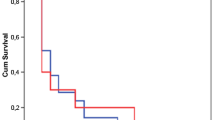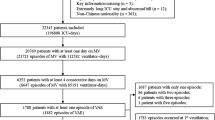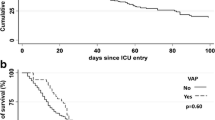Abstract
Background: Ventilator-associated pneumonia (VAP) is one of the most common hospital-acquired infections in the intensive care units (ICUs). They have not only an impact on each patient’s individual health but also result in a considerable financial burden for the healthcare system. Our aim was to estimate the cost and mortality rate of VAP on the level III ICUs of the Central Lisbon Hospital Center (CHLC).
Methods: We used a retrospectively cohort design, comparing patients with VAP and without VAP. VAP was defined by international classification of diseases, ninth revision, clinical modification (ICD-9-CM), code 997.31. All patients hospitalized in the 2016 for more than zero days and discharged up to 31 December 2016 with 18 or more years old were included in the CHLC’s four level III ICUs. The identification of episodes and mortality rate was calculated using hospital morbidity database of the Central Administration of the Health System, I.P of 2016. The costs of all episodes were calculated using the CHLC’s analytical accounts of same year.
Results: Of 599 eligible patients, 15 (2.5%) had VAP. The patients with VAP experienced significantly longer hospital stay (39 days versus 18 days, p = 0.001), as well as longer ICU stay (16 days versus 6 days, p < 0.001). The attributable hospital costs for ICU-acquired VAP was significantly higher compared to the patients without infection (30.918,16€ versus 10.575,74€, p < 0,001). There was no statistically significant difference in mortality among the groups (p = 0.623).
Conclusions: VAP is one of the most common hospital-acquired infections in ICUs. ICU-acquired VAP is associated with increased hospital costs and prolonged hospital stay. Hospital management should therefore implement control measurements to keep the incidence of ICU-acquired VAP as low as possible.
Access this chapter
Tax calculation will be finalised at checkout
Purchases are for personal use only
Similar content being viewed by others
References
Direção-Geral da Saúde: Programa de prevenção e controlo de infeções e de resistência aos antimicrobianos 2017. DGS, Lisboa (2017)
Centers for Disease Control and Prevention: National and State Healthcare Associated Infections progress Report. CDC, USA (2016)
Organization for Economic Co-Operation and Development: Health at a Glance: Europe. OECD, Paris (2016)
World Health Organization: The Guidelines on Core Components of Infection Prevention and Control Programmes at the National and Acute Health Care Facility Level. WHO, Genebra (2016)
Agaba, P., Tumukunde, J., Tindimwebwa, J., Kwizera, A.: Nosocomial bacterial infections and their antimicrobial susceptibility patterns among patients in Ugandan intensive care units: a cross sectional study. BMC Res. Notes 10, 349 (2017)
European Centre for Disease Prevention and Control: Point Prevalence Survey of Healthcare-Associated Infections and Antimicrobial Use in European Acute Care Hospitals 2011–2012. ECDC, Solna (2013)
Iordanou, S., Middleton, N., Papathanassoglou, E., Raftopoulos, V.: Surveillance of device associated infections and mortality in a major intensive care unit in the Republic of Cyprus. BMC Infect. Dis. 17, 607 (2017)
Rozanska, A., Wałaszek, M., Wolak, Z., Bulanda, M.: Prolonged hospitalization of patients with hospital acquired pneumoniae in the intensive care unit – morbidity, mortality and costs of. Przegl. Epidemiol. 70(3), 449–461 (2016)
Jansson, M., Kääriäinen, M., Kyngäs, H.: Effectiveness of educational programmes in preventing ventilator-associated pneumonia: a systematic review. J. Hosp. Infect. 84(3), 206–214 (2013)
Datta, P., Rani, H., Chauhan, R., Gombar, S., Chander, J.: Health-care-associated infections: risk factors and epidemiology from an intensive care unit in Northern India. Indian J Anaesth 58(1), 30–35 (2014)
Angelis, G., Murthy, A., Beyersmann, J., Harbarth, S.: Estimating the impact of healthcare-associated infections on length of stay and costs. Clin. Microbiol. Infect. 16(12), 1729–1735 (2010)
Graves, N., Harbarth, S., Beyersmann, J., Barnett, A., Halton, K., Cooper, B.: Estimating the cost of health care-associated infections: mind your p’s and q’s. Clin. Infect. Dis. 50(7), 1017–1021 (2010)
Hunter, J.: Ventilator associated pneumonia. BMJ 29(344), e3325 (2012)
Koening, S., Truwit, J.: Ventilator-associated pneumonia: diagnosis, treatment, and prevention. Clin. Microbiol. Rev. 19(4), 637–657 (2006)
European Centre for Disease Prevention and Control: Healthcare-Associated Infections in Intensive Care Units. ECDC, Solna (2018)
Restrespo, M., Anzueto, A., Arroliga, A.C., Afessa, B., Atkinson, M., Ho, N., et al.: Economic burden of ventilator-associated pneumonia based on total resource utilization. Infect. Control Hosp. Epidemiol. 31(5), 509–515 (2010)
Kollef, M., Hamilton, C., Ernst, F.: Economic impact of ventilator-associated pneumonia in a large matched cohort. Infect. Control HospEpidemiol. 33(3), 250–256 (2012)
Leistner, R., Kankura, L., Bloch, A., Sohr, D., Gastmeier, P., Geffers, C.: Attributable costs of ventilator-associated lower respiratory tract infection (LRTI) acquired on intensive care units: a retrospectively matched cohort study. Antimicrob. Resist. Infect. Control 2, 13 (2013)
Cooper, L., Linde-Zwirble, W.: Medicare intensive care unit use: analysis of incidence, cost, and payment. Crit. Care Med. 32(11), 2247–2253 (2004)
Author information
Authors and Affiliations
Corresponding author
Editor information
Editors and Affiliations
Rights and permissions
Copyright information
© 2019 Springer Nature Switzerland AG
About this paper
Cite this paper
Rodrigues, J., Sousa, P. (2019). Economic and Clinical Impact of Ventilator-Associated Pneumonia in Intensive Care Units of a University Hospital Center. In: Cotrim, T., Serranheira, F., Sousa, P., Hignett, S., Albolino, S., Tartaglia, R. (eds) Health and Social Care Systems of the Future: Demographic Changes, Digital Age and Human Factors. HEPS 2019. Advances in Intelligent Systems and Computing, vol 1012. Springer, Cham. https://doi.org/10.1007/978-3-030-24067-7_16
Download citation
DOI: https://doi.org/10.1007/978-3-030-24067-7_16
Published:
Publisher Name: Springer, Cham
Print ISBN: 978-3-030-24066-0
Online ISBN: 978-3-030-24067-7
eBook Packages: Intelligent Technologies and RoboticsIntelligent Technologies and Robotics (R0)




